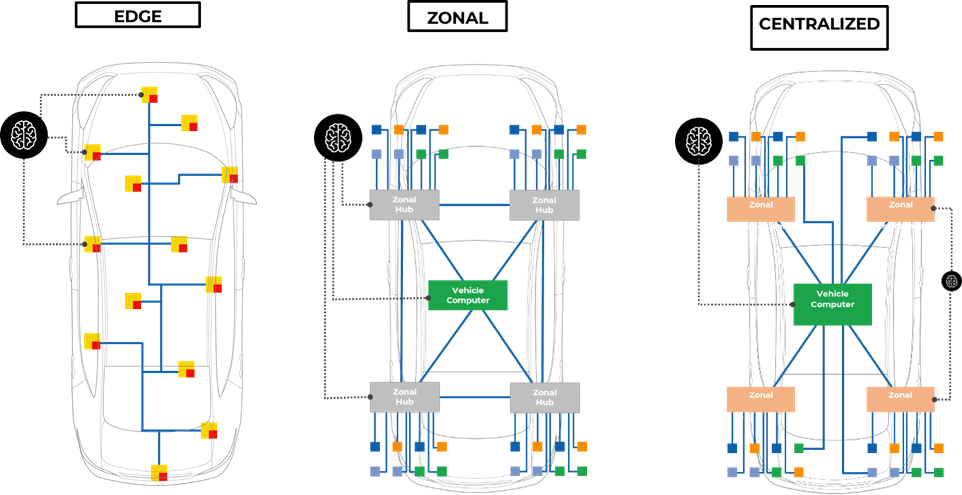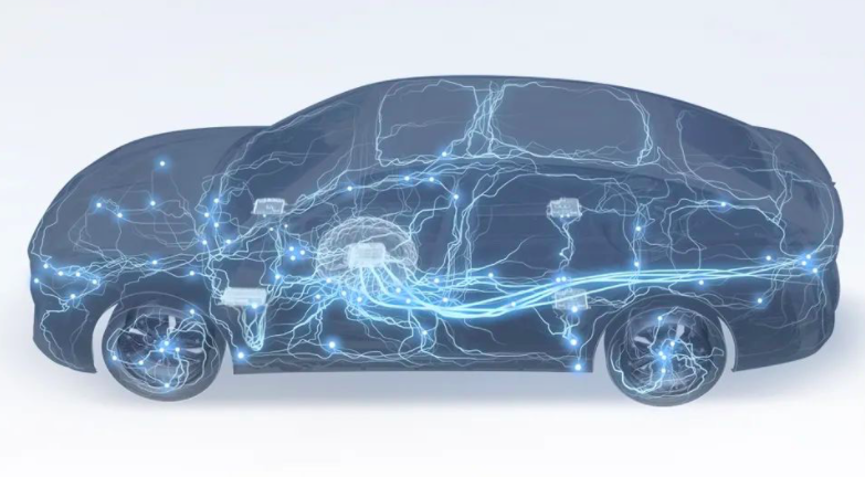Author: Zhu Yulong
As the Chinese automobile industry begins to develop vigorously along the direction of “software-defined cars”, the entire vehicle is developed around the SOA electronic and electrical architecture. The efficient hardware platform, with the central integration of OIB and the sub-domain control of VIU as its core, has strong data processing capability and can take over the active control of the vehicle. With the support of tremendous computing power, not only has the smoothness of the entire vehicle control been improved, but also the vehicle has the ability to upgrade and evolve its hardware throughout its entire lifecycle. Due to the increase in data volume, high-speed data connections have become a necessary choice in intelligent cars.
The electrification era of automobiles and the whole society has arrived, and various EMI-related problems have appeared both inside and outside modern automobile environments.
EMI interference of this kind weakens or damages signals, and the solution to signal transmission is through various links. Once signal problems occur, it may cause critical sensor and ADAS system failures and sometimes even catastrophic consequences.
EMC Issues
Automobiles have strict requirements for electromagnetic interference (EMI) performance, which is one of the most challenging tests that all onboard equipment must face. With the growth of data transmission volume, the requirements for signal transmission speed are becoming faster and faster. The industry is faced with the first challenge of setting limits and required bandwidth for high-speed connection technology. The goal of the automotive industry and manufacturers is to meet the requirements for electromagnetic compatibility (EMC), which can be roughly divided into two main parts:
- Ensuring that electronic devices do not emit too much electromagnetic interference noise (EMI) by themselves;
- Being unaffected by noise from other systems (EMS).
Currently, the main means of reducing the impact of electronic noise and increasing the signal-to-noise ratio (SNR) using traditional technology for automotive connections are reducing bandwidth, reducing cable length, and adding expensive shielded cables. However, all of the above solutions are not optimal and will seriously hinder the high-speed communication of next-generation smart cars.
Reducing Bandwidth
One of the simplest and most effective methods to reduce electronic interference and improve SNR is to reduce bandwidth.
However, as the number of advanced sensing sensors such as cameras, radar, and lidars increases and the quality of transmission improves, the demand for bandwidth will increase rapidly.Here, we can see that the goal of the entire design is to continuously improve the link bandwidth of the EE architecture, which will encounter more difficulties at the technical level. With the enhancement of the edge computing capability of cars, there is a need to increase the extra software transmission demand in theoretical speed. This requires improving the chip’s capacity in the design process. In order to meet the requirements of EMC, it should be based on high-speed transmission and high bandwidth.

Limit cable length
Shortening the distance of signal propagation greatly reduces the impact of electromagnetic interference, because this limits the attenuation of the signal throughout the channel and maintains its original strength. However, the automotive industry is phasing out distributed E / E architectures in favor of domain and centralized E / E architectures to help promote sensor fusion and “software-defined cars” (SDV), and these new automotive architectures require longer wiring (point-to-point connectivity).
We can see that although the overall cable length in the entire centralized architecture is reduced, for individual signals, since they may need to cover the entire vehicle, especially high-speed signals that do not need to be relayed but transmitted directly, the length of signal transmission becomes longer.

Increase frequency
Increasing the frequency can support sending higher bandwidth through a channel, which is a method adopted by some vehicle connectivity solutions to meet current demand. However, signal attenuation increases with the increase of frequency, and the long-distance transmission performance will be affected, which makes the connection cable extremely vulnerable to EMI.
Increase shielding cable.Adding shielded cable can reduce the impact of EMI and also reduce the radiation interference from the cable itself. This solution seems to be very suitable.
However, recent research has pointed out that due to the aging and stress of shielded cables, this solution is particularly problematic in devices that involve movement, such as doors, side mirrors, and trunk lids. EMI has a detrimental effect on shielded cables that are subject to aging and wear, rendering them ineffective and bringing greater risk. Most seriously, as shielded cables lose efficacy over time, the cables themselves become a source of EMI radiation.
▲ Figure 4. As time passes, the shielding effect of the cable decreases, and more noise couples into the signal, weakening the signal-to-noise ratio

Current issues with EMC testing
Currently, the EMC testing methods are mainly focused on new short shielded cables and do not consider the real-world conditions and pressures in which the connecting cables are located. If EMC testing continues in this way, future related vehicles will face massive recalls or other accidents.
Solution —— MIPI A-PHY
To address these challenges, the MIPI A-PHY standard was released in 2020. It supports innovation for achieving advanced autonomous driving in automobiles and uses adaptive methods such as digital signal processing (DSP) to achieve high-bandwidth, long connections, real-time links, and powerful performance in handling EMI issues.
The Valens VA7000 chip uses a DSP that fully complies with the MIPI A-PHY specification and contains three main elements, which can handle EMI:
(1) Real-time Noise Cancellation (JITNC)
It is a fast, adaptive noise cancellation method that reduces the impact of EMI. It is particularly effective at handling narrowband interference (NBI), which is sharp and sudden noise that is difficult for traditional automotive connectivity solutions to handle. JITNC can eliminate noise up to 36dbm.(2) High-order Pulse Amplitude Modulation (PAM)
Valens chipset supports PAM16, a method of transmitting more data within the same time period, allowing for higher data rates while maintaining a lower carrier frequency to prevent signal attenuation and interference. While some traditional automotive connectivity solutions use PAM4, it still cannot support the required high bandwidth of current ADAS and infotainment systems. Valens’ PAM16 not only meets today’s bandwidth requirements but also leaves ample space for future demands.
(3) Dynamic PHY-level retransmission
In environments with high levels of noise, data packets may fail to transmit due to interference. In such cases, the MIPI A-PHY standard requires PHY-level retransmission of the data packet, which allows for extremely fast data transmission. Since the initial EMI that caused the initial failure may not have dissipated, dynamic-controlled retransmission uses a lower PAM than the original transmission. For example, if the original transmission was sent using PAM16, the retransmission will be sent using PAM8. This greatly reduces the chance of transmission failing again, which is one of the reasons why Valens A-PHY compliant chipsets achieve the lowest error rate in the industry.
Valens’ Unique UTP Functionality
The DSP encoding in Valens’ chipset can mitigate the impact of electromagnetic interference, allowing for the use of unshielded twisted pair (UTP) up to 4Gbps and a distance of up to 10m. This provides many advantages, such as reducing system costs, making system design and layout more flexible, and offering more choices when designing system architectures. The application of UTP is a major breakthrough for Valens’ chipset.
Conclusion
Modern vehicles operate in highly complex signal environments. As automotive electronic devices such as ADAS components, digital cockpits, and various other components continue to increase in size, the impact of EMI has been shown to have significant effects on critical systems, resulting in multiple vehicle recalls and even fatalities. Limiting EMI effects should be the primary consideration in all fields. If the automaker’s design does not fully consider this aspect, it will not be able to apply innovative designs in ADAS, V2X communications, infotainment, and other areas to automotive products.# 我们的汽车
欢迎来到我们的汽车展厅,点击此处查看我们的产品。
我们的产品系列
- 紧凑型车型
- Hatchback
- ~~Sedan~~
- 中型车型
- Sedan
- SUV
我们的服务
我们提供以下服务:
- 保修服务
- 保养服务
- 金融服务
有关更多信息,请联系我们的客服部门。
我们的团队
我们有一支经验丰富的团队,包括:
- 优秀的销售人员
- 专业的技术支持人员
- 高效的售后团队
我们始终致力于提供最优质的汽车和服务,感谢您的支持。
This article is a translation by ChatGPT of a Chinese report from 42HOW. If you have any questions about it, please email bd@42how.com.
